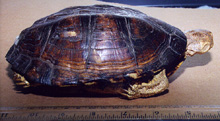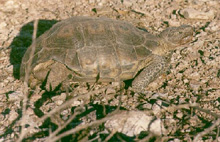Introduction to Chelonia:
The “Crown Group” Turtles
A Story of Survival


Although many early turtle groups fell by the wayside during the evolution of the group Testudines, today’s turtles (the sub-group Chelonia, also referred to as the “crown group” turtles), to a certain extent, are still going strong—but as with many other organisms threatened by humankind, this could change easily, perhaps even in our lifetimes. Many sea turtles especially are near their eve of destruction due to habitat and nesting site loss, pollution, and overhunting, and many land turtles are likewise under siege by the pet trade, habitat loss, and similar encroachments by humans and other threats.
Turtles occupy a noticeable place in Western culture (e.g., Teenage Mutant Ninja Turtles and a 1960s rock group) as well as in other cultures (e.g., Gamera is a rocket-powered turtle in Japanese sci-fi films and Native American art often features turtles). Today, enviromentalist groups often cite the plight of the sea turtles as evidence for the ubiquitous effects of the expansion of human civilization. Perhaps humans, turtles, and the rest of nature need to find a way to be happy together, or we’ll lose these placid reptiles that decorate our culture and are integral components of many ecosystems.

However, if there is one lesson to be learned from turtle history, it is that they are a group of survivors; having passed through several major extinction filters in their long history that other, seemingly “better adapted” groups (such as the other anapsids, the dinosaurs, the giant Pleistocene land mammals, etc.) did not survive. If you were around in the Jurassic period, would you have chosen the few turtles scuttling around to be the holders of a “winning lottery ticket”? Probably not, but nonetheless, the Chelonia have weathered many a storm.

What we’ve presented here is a necessarily brief introduction to the turtles; try our Internet Turtle Resources page or our Chelonia Literature Sources page for much more information. More pages on Chelonia are planned for the near future.
